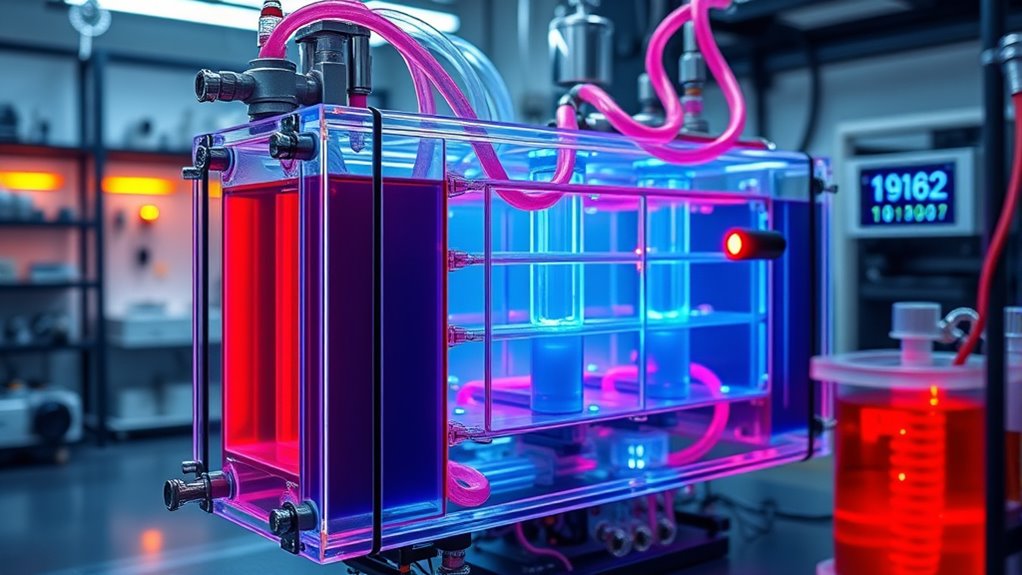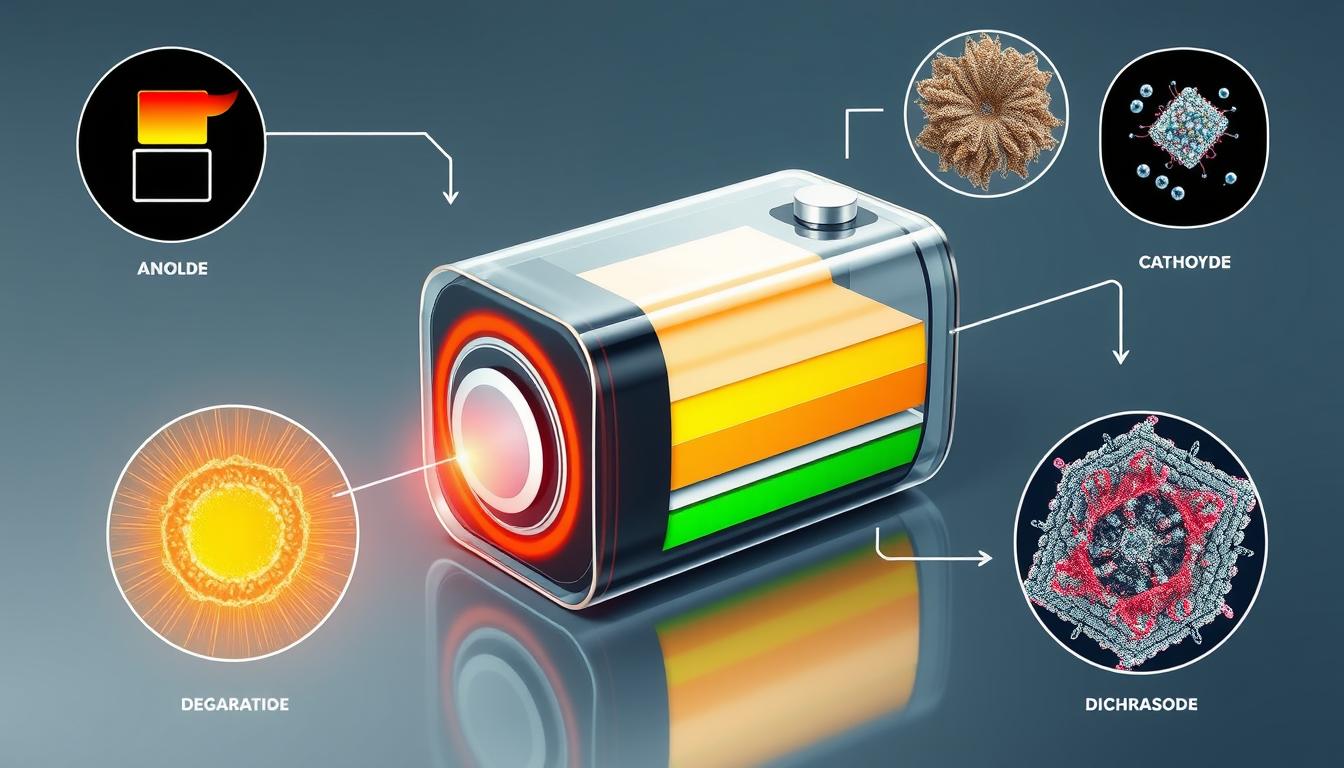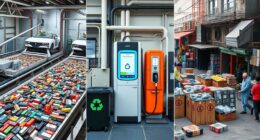Flow batteries are innovative systems that use liquid electrolytes stored in external tanks to store and supply energy. They’re highly flexible and scalable, making them ideal for large-scale needs like grid support and renewable energy integration. You can increase capacity by adding more electrolyte tanks or expanding cell stacks, all without replacing entire systems. If you explore further, you’ll discover how this technology is transforming sustainable energy management.
Key Takeaways
- Flow batteries store energy in liquid electrolytes, enabling scalable and flexible large-scale energy storage solutions.
- Different chemistries like vanadium redox optimize efficiency, lifespan, and operational costs for large applications.
- System capacity and power can be independently expanded by adding tanks or increasing cell stacks.
- Their modular design allows for easy capacity growth without complete system overhaul.
- Ideal for grid stability, renewable integration, and long-term energy management with adaptable infrastructure.

Flow batteries are a type of rechargeable energy storage system that offers a flexible and scalable solution for storing electricity. Unlike traditional batteries, flow batteries store their energy in liquid electrolytes contained within external tanks, which makes them uniquely adaptable for large-scale applications. You can increase their capacity simply by adding more electrolyte tanks, giving them an advantage in system scalability. This ability to expand capacity without overhauling the entire setup is vital for grid storage, renewable energy integration, and other power demands that fluctuate over time.
The core of a flow battery’s performance lies in its electrolyte chemistry. You’ll find that different types of flow batteries utilize various chemistries, such as vanadium redox, zinc-b bromine, or all-vanadium systems. Each chemistry impacts energy density, voltage stability, and overall efficiency. For example, vanadium redox flow batteries are popular because their electrolytes are the same on both sides, reducing cross-contamination and prolonging lifespan. The chemistry determines how well the system can store and release energy, directly influencing operational costs and maintenance requirements. When selecting a flow battery, you’ll want to weigh how its electrolyte chemistry aligns with your specific needs, whether that’s high power output, long cycle life, or cost-effectiveness.
System scalability is one of the standout features of flow batteries. If your energy storage needs grow, you can simply upgrade by adding more electrolyte tanks or expanding the cell stacks. This modularity allows you to start small and scale up as demand increases, without the need for complete system replacement. It’s particularly advantageous in renewable energy projects, where generation capacity can vary considerably. You can also adjust the system’s power and energy capacity independently—power by modifying the electrochemical cell size, and energy by increasing electrolyte volume. This flexibility ensures that your investment remains adaptable to future needs, whether expanding capacity for a new wind farm or providing reliable backup for a grid.
In essence, flow batteries give you the ability to tailor your energy storage setup precisely to your requirements. Their electrolyte chemistry defines how effectively they operate, while their inherent system scalability lets you grow your storage capacity over time. This combination makes them a powerful choice for large-scale energy solutions, helping you manage fluctuations, integrate renewables, and ensure a stable power supply with confidence.
Frequently Asked Questions
What Are the Environmental Impacts of Flow Batteries?
You might wonder about flow batteries‘ environmental impacts. They generally have a lower environmental footprint compared to traditional batteries, thanks to their long lifespan and potential for recycling. However, recyclability concerns remain, especially regarding the electrolytes and materials used. You should consider how their production and disposal could affect ecosystems, but overall, flow batteries offer a more sustainable energy storage solution if properly managed.
How Do Flow Batteries Compare to Other Energy Storage Options?
When comparing energy storage options, you’ll find flow batteries offer scalability, adaptability, and long cycle life, making them ideal for large-scale needs. However, you face scalability challenges and market adoption hurdles, which can slow their widespread use. Unlike traditional batteries, flow systems store energy in liquid electrolytes, enabling easier expansion. You benefit from their potential for sustainability and cost-effectiveness, positioning them as a promising solution amidst evolving energy storage technologies.
What Are the Future Technological Advancements in Flow Battery Design?
You’ll see future advancements in flow batteries focus on advanced material innovations and scalability improvements. These developments aim to make batteries more efficient, durable, and cost-effective. Researchers are exploring new electrode and electrolyte materials to boost energy density and lifespan. Additionally, innovations will likely enhance scalability, allowing larger, more flexible energy storage solutions. These breakthroughs will help flow batteries become even more essential for large-scale renewable energy integration and grid stabilization.
How Cost-Effective Are Flow Batteries for Small-Scale Applications?
You might worry about cost-effectiveness for small-scale flow batteries, but they can actually save you money long-term. While scalability challenges and maintenance requirements exist, advances in technology are making these batteries more affordable and easier to manage. For small setups, flow batteries offer reliable, clean energy storage with lower operational costs, making them a smart investment. Don’t let initial concerns hold you back from harnessing their full potential.
What Are Common Challenges in Implementing Flow Battery Systems?
When you consider implementing flow battery systems, you face common challenges like scalability issues and electrolyte management. Scaling up requires careful planning to guarantee the system remains efficient and cost-effective. Managing the electrolyte involves maintaining its stability and preventing degradation over time. These factors can complicate installation and operation, but with proper design and maintenance, you can overcome these hurdles to successfully deploy large-scale energy storage solutions.
Conclusion
Now that you’ve learned the basics of flow batteries, isn’t it exciting to imagine how they could transform large-scale energy storage? With their ability to store renewable energy efficiently and sustainably, they’re truly redefining the future of power. As technology advances, could flow batteries become the backbone of a greener, more reliable energy grid? The potential is huge—so why not stay curious and keep exploring this innovative solution?










